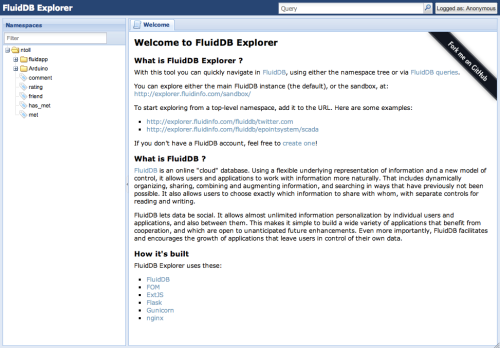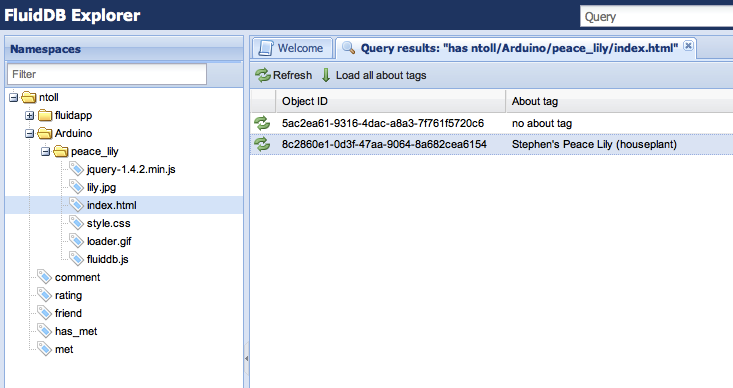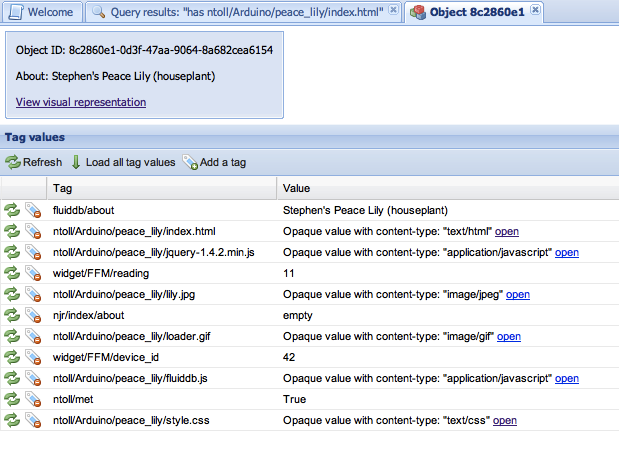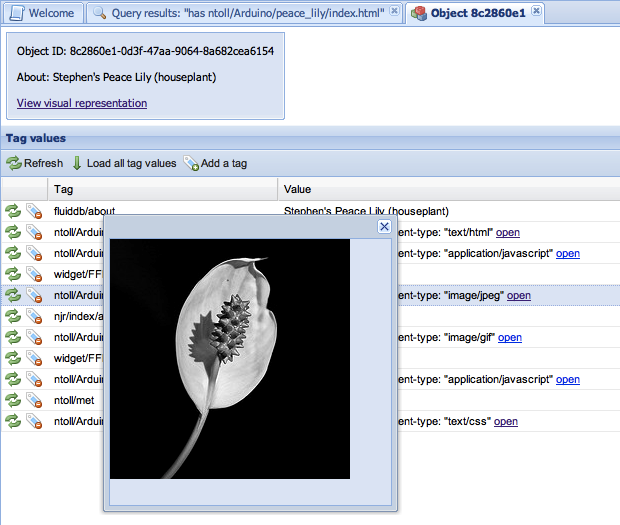Normally users will use applications that use Fluidinfo and are unaware that the application is using Fluidinfo. Programmers will use Fluidinfo through its API. So, what if you’re a non-programmer and not using an application and you just want to have a look around inside Fluidinfo? Pier-Andre Parent has written the Fluidinfo Explorer – a web-based “explorer” GUI. If you’re not a developer, this is probably your best way of starting to interact with Fluidinfo without having to get into all the nitty-gritty details of the API. It’s like the file-system explorer you find on Windows, Mac or Linux.
We’ve found the Explorer so useful that we’ve made it available via the explorer.fluidinfo.com name. The URL you visit in your browser is very important. The pattern is http://explorer.fluidinfo.com/INSTANCE/NAMESPACE where INSTANCE is either “fluidinfo” or “sandbox” and NAMESPACE is name of the user, organisation or application you’re interested in. For example, the following link will display my (ntoll’s) top-level namespace in the explorer: http://explorer.fluidinfo.com/fluidinfo/ntoll
The result will look something like the following:

Notice how the namespace / tag structure is displayed in a collapsable tree control on the left hand side. The main body of the user interface contains a helpful welcome message and at the top right hand side is a search box for queries written in Fluidinfo’s query language and the login button.
Right click a namespace or tag to view and update its attributes, to create and delete namespaces and tags, and to set permissions on them. Clicking on a tag in on the left hand side fills the main area of the UI with all the objects that it has tagged:

So far, so simple…
But what about exploring the tags on a specific object? Click on an objects object id in the result set to display a list of all the tags attached to it. Click “Load all tag values” to display the associated values. Notice how the explorer differentiates between primitive (numbers, booleans, strings etc..) and opaque (images, audio, binary files etc…) values – primitive values are displayed whereas the cells for opaque values contain a description of the type of value stored in Fluidinfo:

Click the “open” link next to each of the opaque tag value to trigger a pop-up with the opaque value presented therein. In this example the value is an image:

Finally, if you follow the “View visual representation” link a rather nice graphical representation of the object is presented to you:

These diagrams are automatically generated by yet another third party application created by Nicholas Radcliffe and hosted on Google’s AppEngine. Given an appropriate URL a rather cool image is generated, e.g., http://abouttag.appspot.com/id/butterfly/8c2860e1-0d3f-47aa-9064-8a682cea6154.
The great thing about the explorer is that it provides an intuitive and visual representation of how Fluidinfo is structured. Have fun exploring!
[…] This post was mentioned on Twitter by Terry Jones, Jeff Gilfelt and others. Jeff Gilfelt said: RT @fluidDB: Introducing the FluidDB Explorer http://bit.ly/hjW4ms Blog post from @ntoll, Explorer written by @paparent. […]
Pingback by Tweets that mention FluidDB » Blog Archive » Introducing the FluidDB Explorer -- Topsy.com — January 10, 2011 @ 9:55 am
Is the source code available for this?
Comment by Matthew Norris — July 17, 2011 @ 11:52 pm
Hi Matthew
The source is at https://launchpad.net/fluidinfo-explorer and the author is Pier-Andre Parent (http://twitter.com/paparent). He hangs out in #fluidinfo on irc.freenode.net where you can join us if you like! 🙂
Terry
Comment by Terry Jones — July 18, 2011 @ 12:46 am